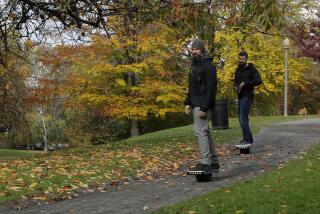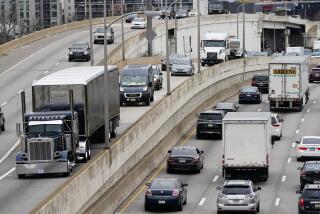U.S. Panel OKs Mandatory Bunk Bed Safety Standards
- Share via
The Consumer Product Safety Commission on Thursday approved mandatory safety regulations for bunk beds, which have been blamed for the deaths of 89 children since 1990.
Voluntary furniture industry guidelines were established in 1992, but federal regulators subsequently have recalled more than 630,000 wood and metal beds that failed to meet them.
Children have continued to die in bunk beds, primarily by slipping through spaces between the mattress or bed frame and the guardrail that are big enough to allow their bodies to pass through, but small enough to trap their heads.
“It is clear from the recalls that nonconformance with the voluntary standard has been a problem,” CPSC Chairwoman Ann Brown said. “A mandatory, rather than voluntary, safety standard will encourage the bunk bed industry to conform, a difference that could mean life or death to children.”
The CPSC rule sets a maximum size for bunk-bed openings, dictates the placement of guardrails and requires warning labels and instructions.
Once the federal standard takes effect next July, the government can move beyond recalls and assess hefty fines against retailers and distributors of unsafe beds. U.S. Customs authorities also will be able to prevent imports of non-compliant bunk beds.
The new federal standard, the Whitney Starks Bunk Bed Rule, is named for an Oklahoma City 3-year-old who strangled when she became stuck between her bunk bed’s frame and guardrail in April 1997.
Lynn Starks, Whitney’s mother, campaigned tirelessly until her home state, Oklahoma, passed a law making voluntary bunk bed standards the law.
“It’s a parent’s worst nightmare,” Starks said on Thursday. “She was a beautiful little girl. I swore her death would not be in vain.”
The California Legislature became the second state to pass mandatory bunk bed standards earlier this year, a move partly designed to prod federal regulators to insist on national requirements. The federal standard will supersede the state laws.
“Hopefully by California passing a law, it made it easier for the federal government to move quickly,” said Assemblywoman Lynne Leach (R-Walnut Creek), the California law’s author. “A national standard makes it easier for retailers and manufacturers who operate across state lines.”
Although established U.S. manufacturers largely comply with the voluntary safety code, fly-by-night operators and foreign bed companies often do not. Last year, CPSC inspectors checked bunk beds at 55 retail stores nationwide, finding unsafe models made by 23 manufacturers.
Not everyone thinks the new rule will keep dangerous beds from reaching consumers, however.
The American Furniture Manufacturers Assn., a trade group that represents bunk bed makers, has opposed mandatory standards, contending that 90% of U.S.-made beds meet the voluntary guidelines and that federal standards would prove unenforceable against makers of the remaining 10%.
Mary Sheila Gall, the commission’s sole Republican and the lone dissenter in Thursday’s 2-1 vote, said officials should work for changes within the voluntary standards process.
“It seems to me a mandatory standard is not a magic wand that suddenly provides 100% compliance,” Gall said.
But many leading manufacturers say mandatory regulations are necessary.
“I saw non-compliant bunks today,” said Pam Julien, vice president of sales and marketing for La Mirada-based Catalina Furniture, the West’s largest bunk bed maker. “You see them everywhere.”
Catalina will not have to alter its designs to meet the new federal rules, she said.
Like the voluntary guidelines, the CPSC’s standard requires that openings in the upper bunk be no more than 3.5 inches and that models bear labels warning that children under the age of 6 should not be placed on the top bed.
The CPSC also toughened the industry code by demanding continuous guardrails on the wall side of the top bunk. California’s law, which becomes moot when the mandatory rule takes effect, was tougher still, mandating continuous guardrails on both sides of the upper bunk.
Associated Press was used in compiling this report.
More to Read
Inside the business of entertainment
The Wide Shot brings you news, analysis and insights on everything from streaming wars to production — and what it all means for the future.
You may occasionally receive promotional content from the Los Angeles Times.










